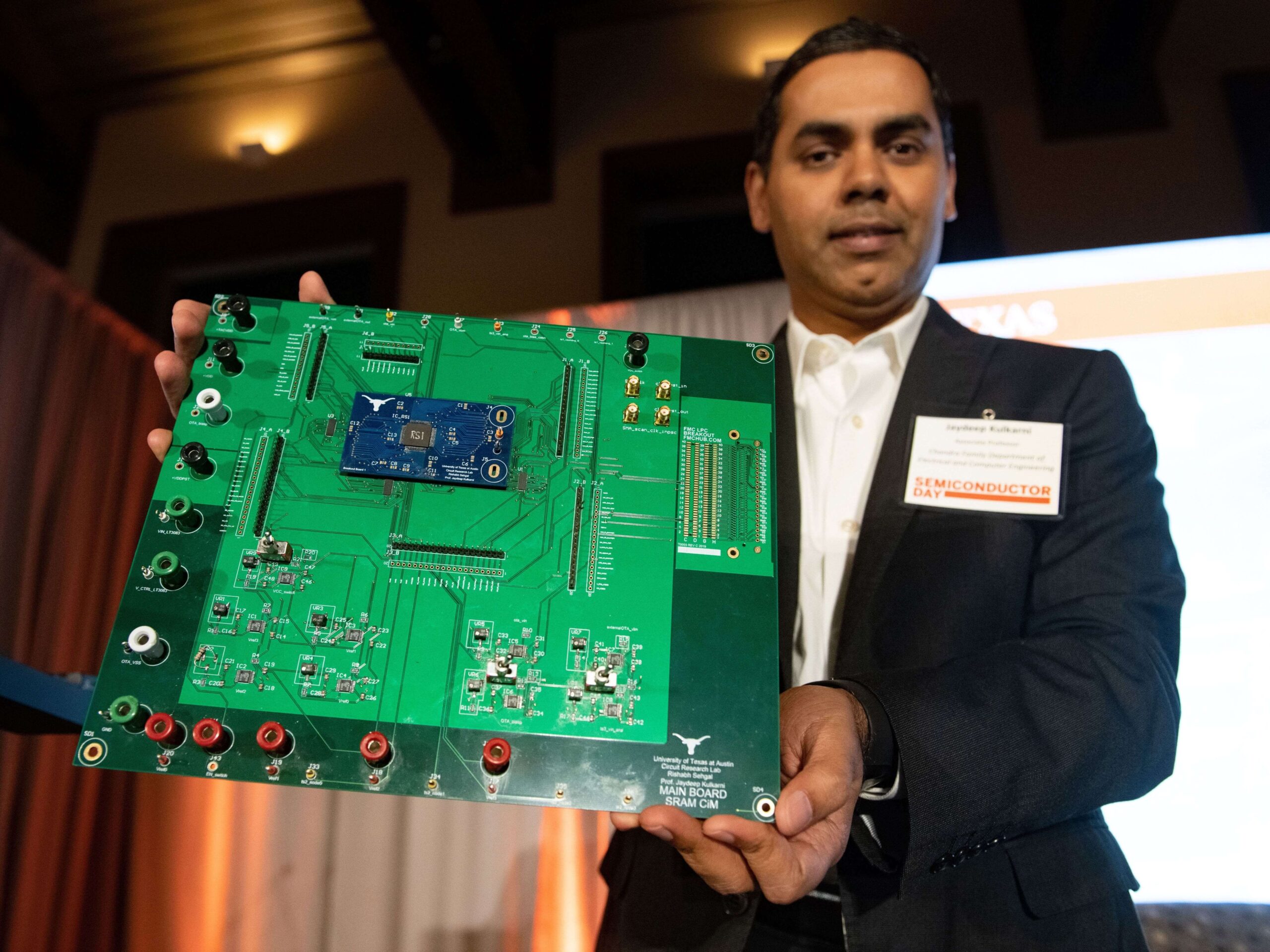A Texas Semiconductor Boom on the Horizon

Jaydeep Kulkarni, Associate Professor, Chandra Family Department of Electrical and Computer Engineering, speaks at Semiconductor Day
In the years since the COVID-19 pandemic crippled the global supply chain for chips that power everything from video games to cars to medical devices, semiconductors have been atop the national policy agenda. These shortages inspired a flurry of legislation, most notably the federal CHIPS Act, that aimed to “re-shore” semiconductor manufacturing in the U.S.
The University of Texas at Austin figures heavily into the national semiconductor picture. Researchers at UT are discovering new ways to improve semiconductors; big companies are investing in this work; and coalitions are bringing together players across the ecosystem to make Texas the center of the surging U.S. semiconductor scene.
All this momentum was on display at Semiconductor Day, an event hosted by the Cockrell School of Engineering and its Chandra Family Department of Electrical and Computer Engineering.
“By continuing to invest in and expand the semiconductor ecosystem at UT Austin, we can propel Texas as a leader both nationally and internationally and become the premiere semiconductor education and research university,” said UT President Jay Hartzell in his remarks at Semiconductor Day.
More than 800 people from all walks of the semiconductor ecosystem attended the event, including students who will represent the future workforce, faculty training these students, companies on the leading edge of semiconductor production and government officials supporting the state as a hub of innovation for semiconductors.
Most recently, the Texas Legislature approved $552 million in funds from the Texas CHIPS Act for the Texas Institute for Electronics (TIE). TIE is a public-private partnership of preeminent semiconductor systems and defense electronics companies, national labs and academic institutions sponsored by UT Austin. The consortium is dedicated to developing semiconductor innovations through advanced packaging and building a semiconductor ecosystem uniting industry, academia and government, and TIE figured heavily into discussions throughout Semiconductor Day.
Speakers included UT leadership, Sen. John Cornyn and U.S. Rep. Lloyd Doggett. Technology companies like Apple, Microsoft, Samsung, NXP, Cornami, Texas Instruments and more were represented. Organizations dedicated to expanding the U.S. semiconductor industry, such as the Global Semiconductor Alliance, detailed challenges and opportunities.
Attendees also heard from UT faculty members from a variety of disciplines working on semiconductor research, including those who have spun out private companies to commercialize their innovations. Björn Manuel Hegelich, a physics professor at UT, started Tau Systems to focus on laser particle accelerators that will help with imaging capabilities in semiconductor development.
Sanjay Banerjee, professor in the Chandra Family Department of Electrical and Computer Engineering and director of the Microelectronics Research Center, showed off a variety of innovative semiconductor research projects. And student research work was on display with a poster session at the event.

Underscoring this momentum, Samsung and UT announced a plan to formalize a years-long partnership between the two organizations to support a semiconductor manufacturing talent development pipeline. Combined gifts from two Samsung units total $3.7 million, and they will support recruiting undergraduate and graduate students to study semiconductor manufacturing in the Cockrell School of Engineering and other key majors across UT, as well as research and development and upgrades to lab facilities.
Workforce development was among the most frequently discussed themes of the day. According to a July report by the Semiconductor Industry Association, the industry’s workforce will grow by nearly 115,000 jobs by 2030. However, due to national degree completion rates in related disciplines, approximately 67,000 of these new jobs are at risk of going unfilled — 27,300 of which are for engineers.
Alliances with companies like Samsung, and support from all sectors of the state, put UT Austin on the path to be a major force in the next wave of semiconductor innovation.
“We have an extraordinary opportunity now in the semiconductor industry that is unlike anything I have seen in my academic career,” said UT Provost Sharon Wood. “The collective support of the Texas Legislature and Federal CHIPS Act, our industry partnerships, our research centers, startups and alumni, give the faculty, students and staff here at UT Austin a significant global advantage in semiconductor research and innovation.”
Semiconductor Vocabulary
Speakers at Semiconductor Day touched on several key themes and phrases that are common within the industry, but less so outside of it. Let’s start with the word of the day itself:
Semiconductors: They are the force that powers most modern technology, from smartphones, to medical devices to clean energy equipment. While most of us think first of the silicon integrated circuits, aka microchips in many electronic devices, a semiconductor can be any material with electrical conductivity between a conductor, like copper, and an insulator, like rubber.
Moore’s Law: An observation made by Intel co-founder Gordon Moore that the number of transistors in integrated circuits double every two years, primarily due to innovation and experience leaps in production, enabling these chips to get smaller and smaller. Many speakers warned that Moore’s Law has to end someday because a chip can only be so small, and that necessitates new approaches to continue growth.
Chiplets, advanced packaging and heterogenous integration: These terms are linked and all related to alternative ways to improve semiconductors as the ability to shrink them diminishes. They generally refer to breaking down larger chips with multiple functions into several smaller, more efficient chips and then using new ways to package them together to reduce power consumption and cost.
